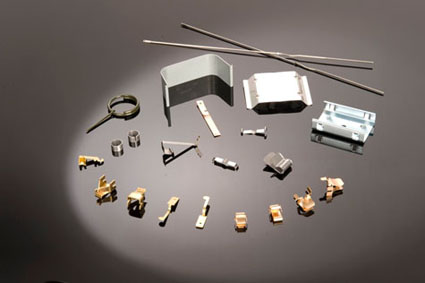
Progressive stamping also called progressive die stamping and progressive metal stamping is one form of metal stamping. It combines bending, coining forming, cutting, and other metal stamping techniques with an automatic feeding system. The feeding system unrolls a strip of coiled metal and pushes it through the various stations in a progressive stamping die. The various stations perform different operations with each stroke of the press as the strip is moved through the die. This action of moving the strip through the die while a different operation takes place at every downward stroke of the press is known as progressive die stamping. Each station of the stamping die works on the metal strip until it reaches the end, at which point the part or component is finished.
Progressive metal stamping that uses a stamping die is one of the most effective techniques for mass manufacturing complicated metal stampings. Progressive metal stamping relies on the metal strip being advanced in a precise manner, so that each operation on the die is accurate.
Many progressive stamping applications involve custom tooling to create a die appropriate to the part or component. Some common metals used in progressive die stamping include aluminum, brass, steel, stainless steel and copper. Progressive metal stamping has applications in many industries, including food and beverage, automotive, electronics, appliances, and more. Contact Rowley today for more information, with a design question, or with a request for a quote.

A fourslide (also referred to as multislide) is a versatile machine that has the ability to run both flat coil stock to make stampings and wire of any type to make wireforms.
Fourslide & Multislide StampingClick to Enlarge
The fourslide fabrication process is not entirely familiar to a number of people within the manufacturing industry and that's because of its specialized nature. It has the ability to make parts with complex shapes and bends that cannot be made compete in a progressive die.
A typical fourslide machine has two main working areas, the die section and the slide section. The first would be the slide area in which each slide is activated by separate cams that move, or "slide" the tool into the coil strip or wire to perform its specific function. Each slide will approach the strip or wire from four different positions, thereby giving it its name "fourslide". Prior to the strip advancing to the slide section, there is a die section. Similar to a progressive die tool, the die will perform the "gutting" (removal of material that is not need to facilitate the part fabrication) and some bends if needed. Not all fourslides have a die section and that's because it is not always needed. Especially in the fabrication of wire forms which can be made with precision tolerances and higher run rates. The principles from fabricating a wireform is the same as stampings, but the use of a die station may not always be necessary.
Rowley Spring and Stamping's diversity in running both fourslide and progressive dies gives us the ability to determine which process will run faster and utilize the material better and provide a high quality part at an effective cost.






